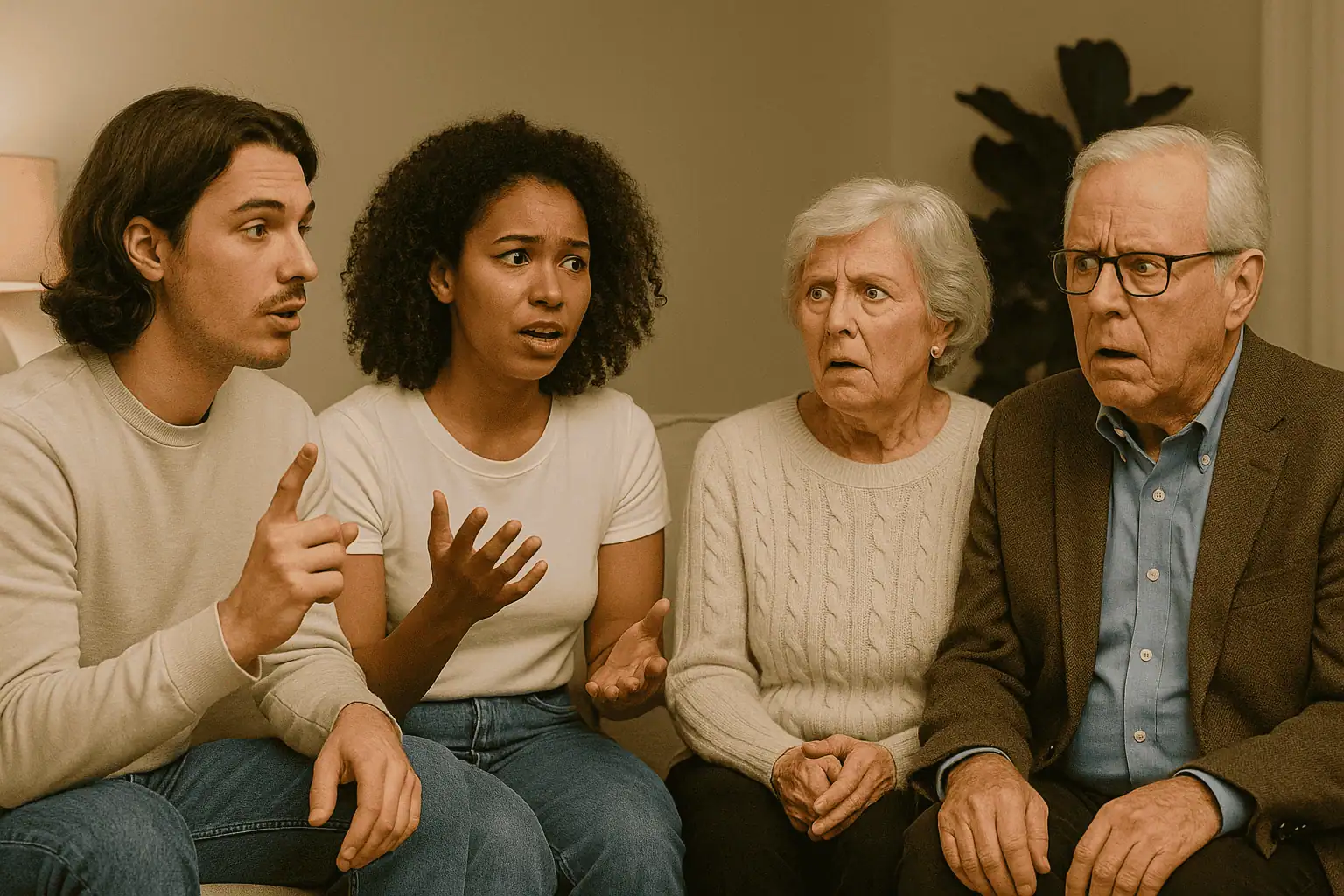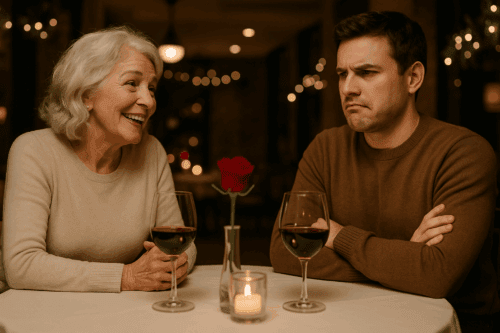
Sex Ed for Boomers by Zoomers: Explaining Modern Sex Trends
Maybe it’s just me, but I get a certain thrill imagining a Baby Boomer’s face when they hear what young people today get up to behind closed (and sometimes open) doors. If you’re from the older generations – say, you learned about the birds and bees from textbooks and hush-hush chats – buckle up. This is a candid ride through the spicy, provocative, boundary-pushing sex trends that Gen Z (yep, us “zoomers”) embrace these days. In other words, consider this a crash course in sex ed for boomers by zoomers.
We’ll spill the tea on everything from the rise of sex toys on nightstands to kinks going mainstream, from polyamory becoming “no biggie” to the wonderfully weird world of digital intimacy.
But hey, don’t get it twisted – it’s not all hedonism and chaos. There’s nuance here (and maybe a dash of irony). Believe it or not, while Gen Z is more open about how we explore sex, many of us are actually having less sex on average than our parents or even grandparents. Surprised? You’re not alone. Consider this the new “wild”: a generation that discusses kinks on TikTok, buys vibrators like candy, questions every old rule in the book – and yet often takes things slow in real life. It’s a fascinating paradox.
Not Your Grandma’s Sex Ed (Seriously)
Let’s start with the obvious: the world has changed, and so has the way young adults approach sex and intimacy. The cringe-worthy, dry lectures in high school health class barely scratched the surface for Gen Z. We basically got our real sex ed from the internet, social media, and each other – for better or worse. Unlike Baby Boomers, who might recall giggling over anatomy diagrams and then figuring out the rest in the backseat of a car, young people today are bombarded (sometimes overwhelmed) with information and misinformation about sex from every direction. It’s like going from a 2D coloring book to a 4K VR headset.
Honestly, this blew my mind: a national survey found that millennials and Gen Z are having fewer sexual partners and less sex than Boomers did at our age. Wait, what? With hookup apps, sexting, and a million dating options, how could that be? Maybe because our “sex ed” came with a side of anxiety and overthinking. We grew up hearing about STDs, consent, online scandals, teen pregnancy on TV – you name it. By the time we hit our teens, some of us were like, “ugh, maybe I’ll just watch Netflix instead.”
Yet, knowledge also opened our minds. We learned about LGBTQ+ identities, kinks, polyamory, sex-positivity, and mental health all at once. We might not be doing it like rabbits, but we sure are talking about it – a lot.
And talk breeds acceptance, experimentation, and a feeling that nothing is too taboo to at least ask. The result? A generation that might seem strangely prudish by the numbers but ultra-provocative in their attitudes. Boomers, buckle up, because the way Gen Z approaches sex could make the free-love 60s look like the stone age.

Sex Ed Spotlight: From Taboo to Toy Story
Let’s talk toys – sex toys. If that makes you blush, take a deep breath and hear this: sex toys are practically mainstream now, even among young adults who aren’t having partnered sex. A staggering 67% of American households now own at least one sex toy. Read that again, that’s over two-thirds of your neighbors! The stigma around vibrators, dildos, and all those funky gadgets is lifting fast. Gen Z grew up seeing stylish ads for scented candles and vibrators side by side on Instagram. To us, a cute pastel-colored toy on the nightstand is just part of a normal self-care routine – like face masks, but make it spicy.
From Secret Shame to Shopping Cart
Remember when buying vibrators meant slinking into some shady shop in the sketchy part of town? Yeah, not anymore. Now you can add a vibrator to your online shopping cart along with laundry detergent and nobody bats an eye. Online retailers and influencer marketing made these devices as ordinary as ordering a latte. Young people today see toys not as a desperate substitute for “real sex” but as a wellness tool.
And get this: Gen Z is buying more vibrators than anyone else, even as many of them delay traditional relationships. In fact, one insider noted Gen Z sees vibrators not as a backup plan for lack of sex, but a key part of their lifestyle. It’s true – a lot of zoomers feel more in control exploring their own bodies first. We’re a generation raised on the idea of self-love (in every sense). So while our parents or grandparents might have considered a sex toy a scandalous thing (“for lonely housewives or perverts!”), Today, a college girl might buy her first vibrator at 18 and brag about it to friends, and a guy might have a Fleshlight or prostate massager without shame.
Sex Toys Go Mainstream
Oh, and it’s not just solo play anymore. Couples now use toys together openly, like a bullet vibrator during sex or furry handcuffs for playful power play. A 2020 survey found that 77% of Gen Z respondents wanted to try new bedroom toys or experiences. That number is slightly lower than millennials, but still shows Gen Z’s openness. In contrast, only 37% of Baby Boomers said they’d be willing to try something new. Most seem to prefer sticking with familiar routines. No judgment, but the contrast between generations is wild. Grandmas are clutching pearls on Facebook, while grandkids compare Bluetooth sex toys in group chats.
The cultural acceptance is such that even female celebrities openly endorse sex toys for women nowadays – I mean, when Miley Cyrus or Cardi B talk about their favorite vibrators, and Gwyneth Paltrow sells $15,000 sex toy “art” (true story), you know the taboo is dead. Gen Z, raised in this environment, thinks nothing of it. We’re the generation of “do what feels good for you.” And apparently, a lot feels good.
Kinky and Proud: From Fantasies to Full-On BDSM
Now let’s turn up the heat a notch. You know that old saying, “Don’t kink-shame”? Gen Z lives it. What used to be whispered about – BDSM (bondage/discipline, dominance/submission, sadism/masochism), role-playing fantasies, fetishes – has edged into the open. Young adults today are far more likely to admit their kinks or curiosities, and even act on them, than previous generations. If Boomers were all about free love in the ’60s, Zoomers are about free-to-be-freakyin the ’20s.
Let’s be clear: kink isn’t new. There have always been folks who liked a good spanking or a bit of bondage behind closed doors. The difference is, we talk about it now. Blame (or credit) the internet: forums, Reddit threads, TikTok “kinktok” niches – they’ve made it easy for an intrigued 19-year-old to learn about, say, shibari rope art, submissive sex toys, or foot fetishes or whatever floats their boat. What might have once taken a secret trip to a library or a specialty magazine can now be found with a quick search. A quick TikTok scroll or Reddit thread might be all it takes to learn that your roommate is into feet, your coworker is exploring pegging, or your wife wants to be tied up. Kink isn’t hiding anymore—it’s out in the open, sometimes literally trending.
Mainstream Kinks and Consent Culture
So yes, BDSM has gone mainstream-ish. A decade ago, Fifty Shades of Grey blew Boomers’ minds by dragging bondage into pop culture. These days, a young woman might openly tweet, “ugh I need to be choked after that exam” – half-joking, half not – and her friends just “like” the tweet. That casualness would shock many older folks. Rough sex, if consensual, isn’t as taboo a topic for us. Some data even suggested more young women are experimenting with power dynamics (being dominant or submissive) in the bedroom than prior generations – though trust me, we’re also superobsessed with consent and safety while doing so. We may be edgy, but we’re not careless.
Another surprise for the uninitiated: certain fantasies have gained cultural traction. Pegging (Google it, but basically when a woman uses a strap-on to penetrate a man) was an obscure term once; now it’s a meme and a fairly common fantasy among heterosexual couples exploring role reversal. I can practically hear a Boomer dad’s brain exploding at that concept. “You let her put what, where?!” Welcome to modern intimacy, sir. Gender roles in sex are getting rewritten (more on that later), and a lot of guys our age are confident enough to indulge in what older generations would have panicked over as “emasculating.” To us, it’s just another fun Friday night if both partners are into it.
Judgment-Free Sex Ed: Curiosity Without Shame
Let’s also mention fetishes – from tame to bizarre – are easier to discover and discuss. Whether it’s feet, latex outfits, or, I don’t know, people who get turned on by anime characters (it’s a thing), Gen Z’s motto is basically “no big deal, you do you.” Sure, we might privately think someone’s kink is weird, but we’re less likely to shame them openly. Live and let live – as long as it’s consensual and with adults, of course. That doesn’t mean every young person is out there tying their partner up or wearing furry costumes in bed, but many feel they could if they wanted, and that’s the cultural shift. It’s honestly liberating.
One more note: polyamory and open relationships often get lumped in with the “kinky” stuff because they defy tradition. And boy, are many Gen Z-ers defying the one-partner script (we’ll dive into that next). The point here is, variety is welcome in our sexual repertoire. A fantasy that might have sent an different generation running to a therapist or a confessional is now just a spicy topic in a group chat of 22-year-olds. We’re aware, adventurous, and not afraid to at least talk about our deepest curiosities.

One Is Not Enough? The Rise of Polyamory and Open Love
Picture this: it’s 1975 and you tell a Baby Boomer couple at a key party (look it up) that in the future, their grandkids might have multiple romantic partners at once – with everyone’s consent – and it’s not seen as scandalous. They’d probably laugh you out of the room or assume you’re describing some hippie commune. Fast forward to now: polyamory (having more than one loving relationship at a time) is practically a buzzword, and ethical non-monogamy is on the menu for many young adults.
Gen Z Is Over Monogamy
Here’s a stat that might make monogamy enthusiasts clutch their chests: More than half of Gen Z would prefer to keep their romantic options open – literally. One recent survey found that about 59% of Gen Z is interested in open or polyamorous relationships. That’s well over half of zoomers saying, “Happily ever after with just one person? Sounds a bit like dial-up internet – outdated.” In the same vein, nearly half of Gen Z surveyed said one sexual partner isn’t enough to satisfy them. It’s like commitment is an old pair of skinny jeans – some of us still rock it, sure, but it doesn’t fit everyone anymore.
Now, before anyone faints, not every young person is juggling three lovers. But many feel open to the idea, and that matters. Gen Z connects deeply and values openness, growing up with diversity in every form. We question rigid norms, and monogamy feels especially strict in modern romance. So we ask, “Is one-and-only really the only way to love?” For many of us, the answer is no. We’ve watched our parents divorce. We swipe through dating apps where another match is always a tap away. We value personal freedom above tradition. For a lot of Gen Z, polyamory feels like a natural next step. Why limit love when you can share it with multiple people—openly and with consent?
Breaking the Infidelity Myth
Older generations often can’t separate the idea of polyamory from infidelity. They hear open relationship and think “your partner doesn’t truly love you” or “this will end in disaster.” Boomers grew up when even swinging (swapping partners) was scandalous and mostly hush-hush. For Zoomers, seeing someone openly have a primary partner and a secondary partner, or be part of a poly “throuple,” isn’t jaw-dropping anymore – it might warrant a “spill the tea” session, but not outright condemnation.
Is polyamory for everyone? Heck no. Plenty of Gen Z catch feelings for one person at a time and prefer it that way. And being poly doesn’t magically solve the normal pains of dating – sometimes it multiplies them! Jealousy is still real, scheduling multiple date nights is practically a Google Calendar nightmare, and society’s not 100% on board (we still get side-eye). But the big difference is choice. We actually feel we have a choice in our relationship style now. That’s something new. Boomers largely followed the formula (date, marry, kids, etc.), whether they liked it or not, and often quietly suffered if it didn’t fit.
Gender: The Ultimate Fluid Frontier
If you want to see a Boomer’s eyes widen, just mention how Gen Z views gender and sexuality. Older generations saw gender roles as black and white—men did this, women did that. Anything outside heterosexual norms stayed hidden or unspoken. But Gen Z tossed that old rulebook out. Young people today speak openly about gender fluidity, sexual orientation, and who takes what role in the bedroom.
Let’s start with identity: Gen Z is the queerest generation in history in terms of being out and proud. One report found that Gen Z is more likely than any other generation to openly identify as LGBT, according to nymag.com. We’re talking a lot of young folks comfortable saying they’re gay, lesbian, bi, pansexual, asexual, non-binary, transgender – you name it.
It’s not a “phase” or a rebellion; it’s who they are, and they feel freer to live it than their parents or grandparents ever did. A Gen Z straight guy might date a trans woman, or a cis girl might realize she’s bi-curious and hook up with other girls without feeling like it’s a huge identity crisis. It’s just more fluid. Gender isn’t a strict binary in our worldview; it’s a spectrum, and we mingle across it.
Shifting Roles in the Bedroom
Now, even among hetero, cisgender couples, the roles are changing in bed. Remember the earlier mention of pegging? That’s one example of role reversal sexually. There’s also the shift that more women feel empowered to initiate sex, to say what they want, and more men are okay with being gentle or receptive or emotionally vulnerable during intimacy. It’s less “macho man performs, demure woman receives” – instead, we mix it up. Some nights she’s in charge, other nights he is, maybe both at once, who knows. The script is whatever we want it to be.
A Fox survey highlighted that Baby Boomers were the most uncomfortable with gender fluidity – 65% of boomers admitted they feel completely uncomfortable with it. Meanwhile, Millennials and Gen Z are far more comfortable (though even among younger Americans, less than half said they’re totally comfortable with gender-fluid identities, meaning there’s room to grow). But the trend is clear: each younger generation gets more chill about it. We grew up with Orange Is the New Black and Pose on TV, after all – shows featuring trans and nonbinary characters. Our cultural heroes include nonconformists like Sam Smith, Janelle Monáe, or Elliot Page. To us, trans rights and pronouns and unisex bathrooms are just part of the landscape.
Modern Sex Ed: Language, Consent, and Sexual Freedom
What does this mean for sex? It means more people are comfortable in their skin and desires. A gender-fluid or nonbinary person might feel empowered to say “Here’s what I like, regardless of whether it’s considered a ‘guy’ or ‘girl’ thing.” It means couples might swap traditional roles or same-sex experiences aren’t automatically a scandal; plenty of Gen Z who ultimately identify as straight will have had some form of sexual experience with more than one gender, simply because they felt safe enough to explore.
It also means the language of sex is changing. We say “partner” a lot instead of assuming boyfriend/girlfriend, because who knows what gender combination is involved. We specify pronouns and ask each other about boundaries more explicitly. Consent is huge – not that past generations didn’t care, but we really talk about it constantly to the point where it’s basically sexy to ask “Is this okay? Do you like this?” mid-romp. Some Boomers might find that mood-killing (they were used to more… implicit dynamics), but to us it’s normal and respectful.
I know people whose Boomer parents still can’t wrap their heads around the fact that their son wears nail polish or their daughter’s girlfriend sleeps over. Tension exists. But if you zoom out, the trajectory is clear: gender norms are melting away for young adults, and sex is way more fun (and fair) when you’re not confined by “boy vs girl” expectations.
Boomers, I won’t lie, this one might be the hardest to grasp if you haven’t lived it. But trust me, once you see how much happier people are when they can be themselves in intimacy, you’d be hard-pressed to argue the old days were better.

Digital Intimacy: Love and Lust in the Time of OnlyFans
If older generations thought online dating was a big leap (remember when meeting someone on the Internet was seen as sketchy?), they probably couldn’t imagine where we are now. Welcome to the age of digital intimacy: camming, sexting, swiping, snapping, and VR… it’s a whole new frontier.
First up: Sexting and nudes. Sending flirty or explicit texts, pics, and videos is almost a standard phase of modern courtship. Back in a Boomer’s day, the raciest you might get is an erotic Polaroid or, I dunno, a spicy love letter. Now, it’s “nudes?” half-jokingly by the third date (or third message, depending on the vibe). According to some studies, a majority of adults have exchanged sexy photos or messages with someone. It’s practically a new third base. Of course, it comes with risks (we all know someone whose private snap got screenshotted or leaked – yikes), but that hasn’t stopped the trend.
Sex Ed After Dark: OnlyFans and the Hustle Economy
Next, consider how social media and OnlyFans have blurred the lines between personal and public sexuality. OnlyFans, in case you need the primer, is a platform where creators (often everyday young adults) sell content, frequently adult content, to subscribers. That means a college student might be making a side income posting nude or sexual videos to paying fans. It’s like the democratization of porn – anyone can be their own boss and monetize their sex appeal. This would have been unfathomable to an a past generation. But now? There are stories of 22-year-old single moms paying their bills by selling tasteful nudes, or couples who film their intimate moments for an audience as a sort of enterprise. Young people see it as hustle, empowerment, or just exhibitionist fun.
Dating apps continue to shape how we meet and mate. Tinder, Bumble, Hinge – the swipe life is the norm for many young singles (and some not-so-singles in open situationships). It’s a game of endless options, which can lead to wild encounters or analysis paralysis. One night you might be chatting with someone 5 miles away who’s DTF, the next you’re ghosted or you ghost them – the dance is complicated and sometimes brutal.
Boomers might struggle to understand how we can form connections this way, but for us it’s just part of modern dating. It does lead to some very creative (and sometimes dubious) “dating rituals.” Ever heard of “slow fading”? It’s like ghosting but over a long period, gently reducing communication. Or “orbiting,” where someone stops seeing you but still watches all your Instagram stories – a haunting of sorts. We’ve basically invented a whole lexicon for digital-age romance, most of it reflecting how technology has made dating simultaneously easier to start and easier to ditch. Romantic, huh?
The Rise of Remote Pleasure
On the truly futuristic side, we have VR (Virtual Reality) porn and teledildonics. Yes, that’s a word – it refers to high-tech sex toys that can be controlled remotely via the internet. Long-distance lovers can now literally simulate physical intimacy using synced devices. Instead of just watching adult videos, you can experience them more immersively with a headset, feeling like you’re there.
Cam sites deserve a mention too – where live performers (often young women, but also men and nonbinary folks) do sexual or intimate things on camera for tips. It’s interactive; viewers type requests, models respond in real time. It’s a whole subculture of intimacy that’s one part performance, one part real connection (some lonely souls find genuine companionship with their favorite cam model, as odd as that may sound). For some Gen Z, being a cam model is seen as just another gig, safer in some ways than traditional sex work, and for viewers it’s a way to get a personalized experience.
Boomers often worry that all this screen time is making us isolated or that we’re losing the ability to connect face-to-face. There’s some truth to that concern – our generation definitely battles with loneliness and disconnection. But ironically, these digital sexual avenues are often a response to that. We crave intimacy just like any human. If we’re not finding it in traditional ways (perhaps because we’re overworked, socially anxious, or stuck at home), we’ll find it through a screen, however we can. Whether that’s healthy or not is a whole other debate. But it’s the reality we live in.
New Rules, New Rituals: Gen Z’s “Sexploration” Culture
Dating and mating in Gen Z comes with its own weird rulebook – one we’re writing as we go. To older generations, our approach to relationships can look like utter chaos or just plain unrecognizable. Let’s decode a bit of it, because it’s a key part of how modern intimacy plays out.
Firstly, the concept of “dating” itself has morphed. We have this thing called “situationships”, which is basically when you’re more than friends with benefits, but not officially dating – a romantic limbo, if you will. Many young people find themselves in these because, well, commitment can be scary and ambiguity is oddly comfortable for a generation used to juggling options. In the past, you went steady or you didn’t; now you can spend six months kinda-sorta-quasi-datingsomeone without labels. It’s an emotional minefield at times, but it’s common. If a Boomer parent asks a Gen Zer, “So is this person your boyfriend/girlfriend or what?” and the they go “Umm… it’s complicated,” that’s probably a situationship. We’ve basically given a name to something that’s been around forever (unrequited love, casual entanglements), but it’s exceedingly common now.
Sex Ed: Situationships and Slang
Then there’s our slang and rituals. We say “hook up” to cover anything from making out to full-on sex – purposely vague. We talk about “body count” (how many people you’ve slept with) the way older folks might talk about past relationships. Some lament that we treat intimacy as a game of numbers or a casual sport, but it’s more nuanced than that. Sure, there are definitely some who chase encounters for clout (yes, even regular people, not just celebrities, have reputations now thanks to social media). But many of us still deeply value connection – it just might not look like the 1950s courting process.
Another trend: Putting off sex or relationships altogether for longer. Remember one of those big questions: Which generation had the least sex? Newsflash – it might be us, Gen Z. Plenty of studies and headlines have noted that a lot of young adults (particularly men under ~30) are in a sex recession of sorts.
Some are virgins well into their 20s, others have little dating experience. It’s not for lack of interest, necessarily. Sometimes it’s fear (of intimacy, of failure), sometimes it’s just that life is expensive and hard and who has the energy to woo someone when you’re drowning in student debt and global existential dread? Dark, I know. But it’s part of the picture. I mention this because the flashy trends – the camming, the polyamory, the kinks – can give the impression that every Zoomer is having a wild sex party every weekend. Not true. A lot are lonely, or shy, or just very cautious.
Why Some Gen Z Folks Opt Out
We navigate a strange mix of messages: hyper-sexual media on one side, and a hyper-aware culture of consent and potential consequences on the other. Many young people view casual sex as risky—not just because of STDs or pregnancy, but also due to emotional fallout or the threat of social and legal backlash. No one wants to get labeled a creep or face harassment accusations. So, some choose to delay or avoid it altogether. Older generations might relate to this fear-driven abstinence—but unlike theirs, ours comes from within, not just from strict parenting.
All that said, Gen Z has a remarkable ability to create community around these issues. We love to share experiences and advice in our online spaces – whether it’s a YouTube vlogger giving a “sex ed 101” tutorial, or a Twitter thread about dealing with relationship anxiety, or a support group on Reddit for late bloomers. There’s basically a community for every niche feeling you have, sexually or romantically. Feeling like the only virgin in your college? There’s an online forum for that – and spoiler, you’re not the only one. Curious about trying BDSM but too scared? Hundreds of anonymous others will chat with you about how they dipped their toes in safely.
New Kind of Connection
Honestly, at times I envy the simplicity of the old Boomer dating scene – you “went steady” and that was it. No endless options, no 500 labels for every preference, no fear that your nudes will end up on the internet (biggest relief, I’m sure). But then I remember: a lot was also repressed back then. People stayed in unhappy marriages because divorce was taboo. LGBTQ folks stayed in the closet or married straight and suffered silently. Women often didn’t get to explore their sexuality without judgment. So I wouldn’t trade the freedom and knowledge we have now. It comes with confusion, sure, but I’ll take confusion over denial any day.

Timeless Lessons from Sex Ed: The More Things Change…
We’ve explored a lot: sex toys on the nightstand, sexting beneath the sheets, shifting gender roles, and redefining what “relationships” even mean. It’s a lot to process—even for those of us living it. Gen Z’s approach to intimacy can feel contradictory at times: open-minded yet anxious, hypersexual online but sometimes undersexed in real life. Still, one thing’s for sure—it’s never boring.
Here’s the twist: even with all the changes, some things remain the same. Young people still fall deeply in love and get their hearts broken. We still get butterflies on first dates, whether we met on an app or at a café. And we still gossip with friends about who did what with whom. We still want meaningful connection. Many of us eventually want what our grandparents did—companionship, maybe family, someone to hold our hand when we’re old.
And Boomers were once considered the radical ones. They pioneered the sexual revolution that made a lot of our freedoms possible. They fought for birth control, women’s liberation, and rock n’ roll that drove their parents crazy—and probably led to a few backseat pregnancies. Every generation gets a turn to shock the one before it. Now it’s ours. With a new wave of sex ed shaped by openness, tech, and platforms like JackandJillAdult.com, Gen Z is flipping the script in ways their grandparents never saw coming.

